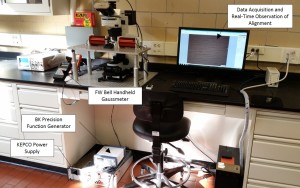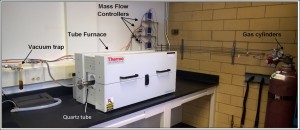Real-time observation of particle assembly in oscillating magnetic fields
This experimental set-up allows for the real-time observation of magnetic micro- or nanoparticle alignment at low frequencies. The set-up primarily consists of a power supply, a gaussmeter, digital microscope, and a solenoid pair in series. The magnetic field produced between the solenoid pair can be DC or AC, and is approximately uniform. The digital microscope is capable of resolving submicron features. In addition, the alignment characteristics can be quantified using in-house Matlab codes.
- Real-time imaging of magnetic assembly: 346 um x 260 um region, resolution down to 135 nm
- Produce nearly uniform magnetic fields
- Controllable magnetic flux density: ~100 – 500 G
- AC/DC magnetic fields; square, sine, or triangle waveforms, ~0.1 – 5 Hz
- Sample size: 1” long x 1” wide x 0.25” high
- Continuous operation without overheating
- Quantitative representation of particle alignment
Triaxial Helmholtz Coil System (funded by ONR DURIP)
This experimental set-up allows triaxial application of magnetic fields application to nano-structure and/or actuate polymer nanocomposites. The system comes with the software that controls magnetic field density, wave form, phase difference developed by MicroMagnetics.
- Produce nearly uniform magnetic fields
- Controllable magnetic flux density: ±300 x ±250 x ±180 G max
- DC and sinusoidal: < 1 Hz
- Phase shift: 0 -180 degrees
- Sample size: 1.5” long x 2.5” wide x 3.5” high
- Continuous operation without overheating (< 100 oC)
Chemical vapor deposition (CVD) of multi-walled carbon nanotubes
The setup comprises of a single-zone tube furnace (max temp 1200 oC) with a quartz tube having diameter of 1.5”. The process gases include argon, ethylene (C2H4) and hydrogen (H2) which are regulated using individual Mass Flow Controllers (~500 sccm). The gas flow connections are made of ¼” SS tubing to ensure no leakage. The exhaust gases are passed through a vacuum trap and then to a fume hood for ventilation.










